Abstract
Background: In 2004, a new postgraduate medical training system was introduced in Japan and a shift of new graduates from university hospitals to other postgraduate education hospitals happened.
Aim: The aim of this study is to analyse the past trends on postgraduate medical education choices and subsequent career options to discuss possible outcomes of the current shift and policy implications.
Methods: Data from the national physician survey from 1976 to 2006 were analysed. The proportion change of physicians started their career in university hospitals was calculated. The career paths for physicians by different residency type were presented.
Results: More than 90% of physicians experienced university hospital work at least once in their 20-year careers. In their first 10 years of their career, physicians who started their residency in a university hospital tended to spend more years working in university hospitals, and those who started in other post-graduate training hospitals tended to spend less in university hospitals. Then, these groups presented quite similar patterns in their career choices.
Conclusions: University hospitals need to strengthen their function as continuing education and career development centres and to adopt a less paternalistic approach, as fewer residents start their career in university hospitals.
Introduction
Undergraduate medical education, postgraduate medical education and continuing medical education are integral components of medical education and their effective coordination contributes to the establishment of robust healthcare systems. Research and discussions on when, where and how these aspects of education are provided and their outcomes provide a planning basis for all those involved in medical education policy around the world.
In Japan, there are 79 medical schools, which represent approximately one school for every 1.6 million people. Following graduation from high school, aspiring physicians undertake their 6-year undergraduate medical education, followed by the national examination. Those who obtain a national license and intend to practice clinical medicine proceed with the obligatory postgraduate clinical training programme for 2 years. In the first year, no less than 6 months of general internal medicine, general surgery and emergency medicine (including anaesthesiology) are required courses. Paediatrics, obstetrics and gynaecology, psychiatry and community medicine are additional recommended training areas. Advanced postgraduate clinical training for medical specialties takes between 4 and 6 years, and then the physicians can sit for the board examination (Kozu Citation2006).
Prior to 2004, Japanese university hospitals functioned as a powerful mechanism for allocating physicians around the country, and they played a key role in distributing physicians into rural areas (Nomura et al. Citation2008a). Majority of newly registered physicians entered the training programmes designed and implemented by the clinical department of their medical school (Ushiba Citation1985; Teo Citation2007). Although the postgraduate clinical training programme was offered both in university hospitals and other postgraduate medical education hospitals, more than 70% of the newly registered physicians received their postgraduate medical training at the university hospital affiliated with their medical school, and most of these medical residents were trained in one specialty. A positive aspect of this process was that physicians did not have to conduct job searches, and hospitals could maintain their workforce without engaging in a rigorous recruitment process (Otaki Citation1998). On the other hand, for the large proportion of residents whose training was restricted to a particular specialty, particularly among those trained in university hospitals, their confidence level to engage in general practice and to perform some other basic skills was relatively low (Yano et al. Citation1992).
In 2004, a new postgraduate medical training system was introduced. It mandated that physicians rotate between different areas of practice during their 2-year training programme. At the same time, a nationwide matching system was introduced to coordinate the needs of newly graduated medical students and those of postgraduate medical training facilities. Then, young physicians sought more training opportunities in various settings as well as better working conditions. Thus, a shift occurred in the popular choice of postgraduate medical training locations, from university hospitals to other postgraduate education hospitals.
The purpose of this study was to elucidate the career path of physicians whose medical residency was started in university hospitals and those in other postgraduate education hospitals, and to discuss the related policy implications. Although an analysis of past trends might not be fully indicative of current trends, such information on postgraduate medical education choices and subsequent career options is useful in discussing possible outcomes of the current shift of new graduates from university hospitals to other postgraduate education hospitals.
There have been many previous studies discussing physicians’ career paths in various countries. Several retrospective cohort studies were conducted with regard to long-term postgraduate career achievements among physicians (Langwell Citation1980; Lambert et al. Citation1996; Ryten et al. Citation1998; Vial & Muller Citation1998; Robinowitz et al. 1999). Longitudinal changes in physicians’ career paths among Japanese physician cohorts were illustrated (Ide et al. Citation2009; Koike et al. Citation2009a). However, these studies did not focus on career differences between physicians who had their medical residency in university hospitals and those in other postgraduate education residency hospitals. So this study is the first attempt to consider hospital types and career differences in a nationwide retrospective cohort covering more than two decades.
Methods
We obtained national census survey data on physicians from 1976 to 2006, with permission from the Ministry of Health, Labour and Welfare. Their survey was conducted every year until 1982 and then every 2 years. To adjust for these varying survey intervals, we used even-year survey data for our analysis. The national survey from which our data were obtained is designed as a census survey, so the response rate to the survey is estimated to be more than 90% (Shimada & Kondo Citation2004). The data included each physician's year of registration, gender, age, workplace municipality code and type of specialty and facility type (university hospitals, other hospitals, clinics and others) as of the end of the survey year. The Ministry did not provide us with the names of the physicians or their facilities, which could be used to identify individuals.
First, we calculated the proportion of those who started their career in university hospitals as of their year of registration of 1976–2006. Second, we counted the number of physicians according to where they work (type of facility, and whether urban or rural), whether they stayed in their original prefecture (a prefecture is an administrative district similar to a state), and their specialty as of 20 years after registration (i.e. 1996 status for the 1976 cohort, 2006 status for the 1986 cohort). We have graphically illustrated how physicians migrated from their original facility type (e.g. university hospitals or other postgraduate education hospitals) as of their year of registration (year 0) to other types of facilities (e.g. university hospitals, other postgraduate education hospitals, clinics and others such as nursing homes or public health centres) in their respective year of experience at the time of the most recent survey of 2006, that is, over 30 years for the 1976 registration cohort and over 20 years for the 1986 registration cohort.
For our statistical analysis, chi-squared tests were conducted for specialty distribution. In each specialty, 2 × 2 tables were constructed (respective specialties or all other specialties versus those who started their career in university hospitals or other postgraduate education hospitals (or those initially trained in other education hospitals and who had never experienced university hospitals)).
Results
Distribution of physicians in their 1st year as licensed physicians
In the 1976 and 2002 registration cohorts, around 70% of physicians started their career in university hospitals and the rest in other postgraduate education hospitals. This rate dropped sharply in the 2004 cohort. Female physicians were more likely to start their career in university hospitals ().
Figure 1. Proportion of physicians with 1st year of postgraduate clinical training at university hospitals. Note: After the new postgraduate training system was introduced, the proportion of physicians trained at university hospitals sharply dropped. Female physicians tend to choose university hospitals as their facility for postgraduate training.
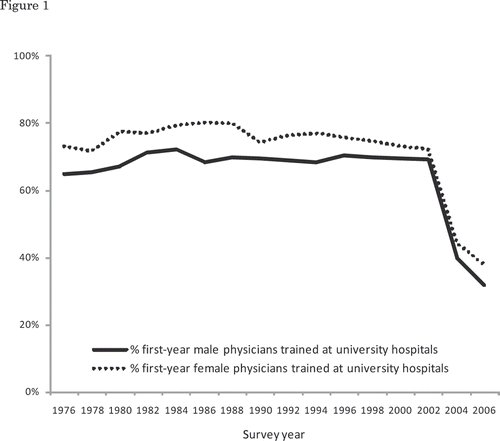
Physicians’ 20-year career choices and comparison of two registration cohorts
Physicians’ facility type distribution, urban/rural distribution, and stay rate (percentage that stayed in their original prefecture and specialty for over 20 years since their registration) were assessed for the 1976 cohort () and 1986 cohort ().
Table 1. Distribution of physicians 20 years after registration (1976 cohort (1996 survey))
Table 2. Distribution of physicians 20 years after registration (1976 cohort (1996 survey))
Through 20 years of work, the distribution of physicians among different facility types maintained a similar pattern. With regard to their urban/rural distribution, those who started their career in other postgraduate education hospitals, and in particular those who never experienced work in university hospitals, showed a higher rate of working in villages and towns, in both registration cohorts.
Of the physicians, 7.6% (1976 cohort) and 7.7% (1986 cohort) had no experience working in university hospitals in 20 years of their career. Those who never experienced work in university hospitals had a higher rate of staying in the same prefecture.
With regard to the choice of specialty, in both registration cohorts, those who started their career in university hospitals had a higher rate of choosing ophthalmology, otolaryngology, dermatology, anaesthesiology, urology and radiology. Those who started their career in other postgraduate education hospitals were more likely to choose general internal medicine and general surgery in both registration cohorts. Those who started in postgraduate education hospitals, but did not experience work in university hospitals more frequently chose internal medicine in both registration cohorts.
Career choices regarding types of medical facilities
The career records in terms of the chosen types of facilities for the 1976 and 1986 registration cohorts, with follow-up periods of 30 years and 20 years, respectively, are presented in . In comparing the two cohorts, the 1986 cohort had a higher proportion of those who chose to work in university hospitals, especially earlier in their career. Subsequently, both cohorts showed quite similar career paths.
Figure 2. Physician distribution by facility type for physicians who started their career in university hospitals in 1976 (n = 2264), followed up over 30 years (until 2006). Note: Among physicians who started their career in university hospitals, in their 2nd year, only 38.5% of them stayed at university hospitals, whereas 45.1% migrated to other hospitals. In their 4th year, some came back to university hospitals, (45.5% in university hospitals and 37.9% in other hospitals). Then the proportion in university hospitals started to decline and that in clinics started to increase. The proportion in other hospitals surpassed that of university hospitals in their 6th year (university 39.5%, other hospitals 42.1%). The proportion of clinics surpassed that of university hospitals in the 14th year (clinics 25.0%, university hospitals 18.4%). Clinics surpassed that of other hospitals in the 24th year (other hospitals 38.3% and clinics 40.9%).
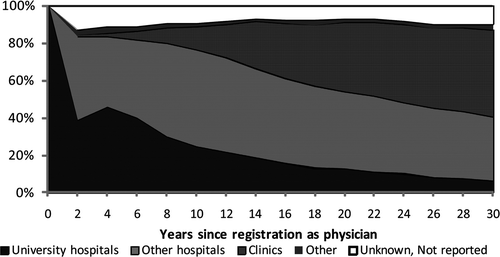
Figure 3. Physician distribution by facility type for physicians who started their career in other postgraduate education hospitals in 1976 (n = 1005) followed up for 30 years (until 2006). Note: Among physicians who started their career at other postgraduate educational hospitals, in their 2nd year 58.0% of them stayed at other hospitals, whereas 26.2% migrated to university hospitals. In their 4th year, those who migrated to university hospitals peaked at 29.6%, and 55.5% stayed in other hospitals. Then the proportion at university hospitals started to decline and that at clinics started to increase. The proportion at other hospitals again increased to reach at 62.2% at 10 years of experience, then started to decline. The proportion at clinics surpassed that at university hospitals in the 12th year (clinics 16.4%, university hospitals 13.7%). The proportion at clinics surpassed that at other hospitals in the 24th year (other hospitals 40.9% and clinics 41.5%).
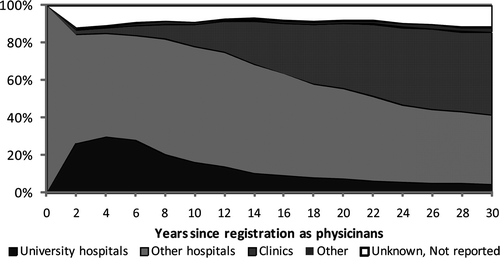
Figure 4. Physician distribution by facility type for physicians who started their career in university hospitals in 1986 (n = 5009), followed up for 20 years (until 2006). Note: Among physicians who started their career at university hospitals, in their 2nd year only 32.0% of them stayed at university hospitals, whereas 59.4% migrated to other hospitals. In their 4th year, some returned to university hospitals (36.7% in university hospitals and 49.1% in other hospitals). Then the proportion at university hospitals started to decline and that at clinics started to increase. The proportion at clinics surpassed that at university hospitals in the 14th year (clinics 22.7%, university hospitals 18.7%).
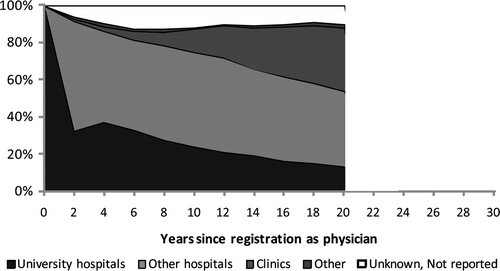
Figure 5. Physician distribution by facility type for physicians who started their career in other postgraduate education hospitals in 1986 (n = 1969), followed up for 20 years (until 2006). Note: Among physicians who started their career at other postgraduate educational hospitals, in their 2nd year 69.1% of them stayed at other hospitals, whereas 18.1% migrated to university hospitals. In their 4th year, those who migrated to university hospital peaked at 23.5%, and 57.8% stayed in other hospitals. Then the proportion at university hospitals started to decline and that at clinics started to increase. The proportion at other hospitals again increased to reach at 58.6% in 10 years of experience then started to decline. The proportion of clinics surpassed that of university hospitals in the 14th year (clinics 19.7%, university hospitals 12.9%).
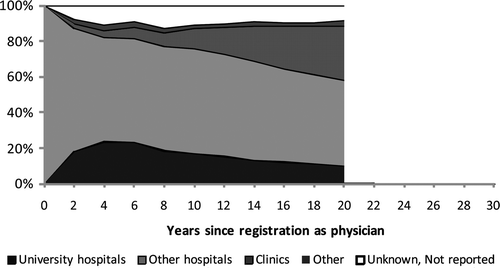
In the earlier stage (first 10 years) of their career, the two cohorts present a different pattern. Among those who started their career in university hospitals, over 60% moved to other postgraduate education hospitals in their 2nd year and returned to university hospitals in their 4th year, and then the number of physicians in university hospitals started to decrease. Then, after 10 years, they started to shift to clinical positions. In the 1976 cohort, it took more than two decades for the number of physicians working for clinics to surpass that of hospitals. For those who started their career in other postgraduate education hospitals, in their second and 4th year of experience, 20% and 30%, respectively, moved back to university hospitals, and then gradually started to shift to clinics. Similar to those who started in university hospitals, among physicians starting in postgraduate education hospitals in the 1976 cohort, it took more than two decades for the number of those working for clinics to surpass those in hospitals.
Discussion
Facility type for postgraduate medical training and subsequent career path
The results of our study show that whether physicians started their career in university hospitals or other postgraduate education hospitals affected their career path in their first 10 years of work. After this point, however, the two groups presented a quite similar pattern in their career choices. In terms of specialty distribution, those who started their career in university hospitals presented a higher proportion of certain specialties such as ophthalmology, otolaryngology, dermatology, urology, radiology and anaesthesiology, which are more common in university hospitals, while for other specialties, university and other postgraduate education hospitals presented a similar distribution.
One possible reason for the similar distribution pattern in some specialties is the role of university hospitals as the hub of career development, as more than 90% of physicians experienced work in university hospitals at least once in 20 years of their career. As medical schools functioned as a distribution mechanism of physicians by assigning physicians to local hospitals on a rotation basis even beyond the residency programme, physicians stayed in close contact with university hospitals. With the mixture of university and other postgraduate education hospital sub-cohorts, through their experience at university hospitals, Japanese physicians’ career paths presented similar patterns.
Physician shortages and the new postgraduate medical training system in Japan
The number of physicians per population in Japan is low compared with other organisation for economic cooperation and development (OECD) countries (OECD Citation2008). Although the number of physicians per population has increased as new medical schools have been founded, the geographical maldistribution of physicians has not improved sufficiently (Kobayashi & Takaki Citation1992; Inoue et al. Citation2009). With technological advancements and changes in patient demand, the resulting tendencies in physicians’ choosing specialties and in urban practice accelerated the maldistribution of physicians. Recognising a physician shortage in Japan, the government is now increasing the enrolment capacity of medical schools.
Our study shows that whether physicians completed their residency in university hospitals or other postgraduate education hospitals did not affect their long-term distribution, but their distribution might change in the short term. So, the implication of our results is that if the past trends continue, the shift of physicians from university hospitals to other postgraduate education hospitals will not affect physician distribution in the long run. In addition, in terms of the physician shortage, with the skewed age distribution of physicians caused by the increase in the number of medical schools and their capacity in the 1970s, the number of newly registered physicians will still surpass the number of retiring physicians, because current retiring physicians were licensed when the medical school enrolment was still small.
As the physician distribution might change in the short term, policy interventions need to be considered very soon in addition to increasing medical school capacity, as it takes a long time to increase the physician workforce. Since recruiting foreign medical school graduates is not an effective short-term measure in Japan due to the language barrier, a revision is needed for the role and function of labour distribution among physicians and other medical professionals including nurses, so as to lessen the burden of physicians. Allowing the delegation of some medical tasks to nurses and other medical professionals should be considered as a way to alleviate the burden of physicians. Currently, a government committee for the promotion of ‘team-based medicine’ is in discussion on the expansion of nurses’ scope of responsibility within the current legal system as well as beyond the current system. Under the current system, nurses’ role in triage, medication dosage adjustments and consultation and explanation to patients and their families could be expanded, and these points have been clarified in a government notice. Other possible policy option that is under continuous debate, and which goes beyond the present qualification system, is the creation of new professional similar to a nurse practitioner.
Role of university hospitals
University hospitals have three key functions: to undertake research, to provide clinical care and to teach new medical school graduates (Hayward Citation2009). There has been a tendency for university hospitals to deal more with tertiary care, while some non-university community hospitals have dealt mostly with community care (Yano et al. Citation1992). Currently the majority of graduates start their career in other postgraduate education hospitals, so the role of university hospitals should be changed accordingly. Recently, medical residents’ clinical experience and confidence levels were reported to have increased (Nomura et al. Citation2008b), and now more than half of new graduates receive their postgraduate clinical training at non-university hospitals.
Our results revealed that even among those who started their medical career in other postgraduate education hospitals, more than 90% had worked in a university hospital at least once in the first 20 years of their career. Now that the new clinical training system has been introduced and fewer medical school graduates are starting their career in other postgraduate education hospitals, the role of university hospitals should be as a hub for physician career development.
The role of university hospitals needs to evolve. Previously, Japanese postgraduate medical education was regarded as an apprenticeship-based system (Bleakley et al. Citation2008) and even after the residency was completed, this relationship continued. In each medical school, clinical departments and academic departments were closely connected. Academic departments had the right to award doctoral degrees, a strong incentive for younger trainees, and the clinical departments developed a pool of physicians to enable rotating physicians among connected hospitals. At that time, most hospitals did not tend to recruit new graduates; this clinical department-centred system was often compared with the feudal hierarchy system (Onishi & Yoshida Citation2004). In this regard, under the old system, university hospitals could take a paternalistic approach, with physicians largely under their control.
As more residents are starting their career in other postgraduate education hospitals, and so residents can compare different hospital experiences, this paternalistic approach should be changed. In addition, the proportion of female physicians has been increasing and our medical professionals’ environment is changing. In Japan, a decline in workforce participation especially among young female physicians has been reported (Kaneto et al. Citation2009). As the specialty preferences are different in female physicians, a further increase of physicians will also affect the specialty distribution of physicians (Koike et al. Citation2009b). Demoralisation of physicians because of emotional public reports of medical errors has been seen (Yasunaga Citation2008). In such a situation, university hospitals need to undertake a more flexible approach rather than a paternalistic approach, and so, university hospitals will be able to assist physicians in their career development and, in coordination with other hospitals, to function as a centre for continuing education.
Limitations of this study
This study has several limitations. First, we chose the 1976 and 1986 cohorts so as to contrast two cohorts, but there may be a selection bias for these cohorts that should be considered. Second, the function of different clinical facilities has changed over time, in terms of available resources and the scope of diseases treated. This is especially true for clinics that have developed their capacities and invested in equipment. Japan is known for its highly equipped medical facilities that are present even in rural areas. However, this study highlights the importance of analysing physician career paths at a national level over a long period of time and drawing possible conclusions and implications that can be applied in other countries. Third, physician specialties are self-designated in the National Physician Survey, and there is no designated primary care specialty in Japan. In addition, it has been reported that physicians in office-based practices often do not limit their practice to the specialty in which they were trained (Starfield & Shi Citation2002). But even with these limitations, our study presents useful information and a discussion base for the role of university hospitals, the provision of continuing education, generalist–specialist coordination and collaboration and physician–nurse collaboration, which are not only domestic policy issues, but may contribute to the wider policy discussion in other countries.
Conclusions
Our analysis of the 1976 and 1986 physician registration cohorts, divided into two sub-cohorts depending on whether they were trained in university hospitals or other postgraduate education hospitals, and followed up to 2006, presents the career path of these cohorts and the shift from their original facilities to other types of facilities over time. Our results suggest that the distribution of facility types reaches equilibrium as the two sub-cohorts careers reach an advanced point. They also reiterate the importance of university hospitals’ providing continuing education, but that there should be a shift from a paternalistic approach to a partnership-based approach as the medical professional environment changes.
Acknowledgements
This study was conducted with support from FY2009 Health and Labour Sciences Research Grants (Research on Regional Medicine) (Chief Researcher: Tomoaki Imamura). We also requested and received permission from the Ministry of Health, Labour and Welfare to use the data collected through their Survey of Physicians, Dentists and Pharmacists.
Declaration of interest: The authors report no conflicts of interest. The authors alone are responsible for the content and writing of the paper.
Additional information
Notes on contributors
Soichi Koike
Soichi Koike is an associate professor in the Department of Planning Information and Management, and manager of Hospital Planning and Management, The University of Tokyo Hospital.
Tomoko Kodama
Tomoko Kodama is the director of the International Health Section, Department of Human Resource Management, National Institute of Public Health of Japan.
Shinya Matsumoto
Shinya Matsumoto is a research fellow, Department of Planning Information and Management, The University of Tokyo Hospital.
Hiroo Ide
Hiroo Ide is an assistant professor, Department of Planning Information and Management and Deputy Director, The Public Relations Center, The University of Tokyo Hospital.
Hideo Yasunaga
Hideo Yasunaga is a project associate professor, Department of Health Management and Policy, Graduate School of Medicine, The University of Tokyo.
Tomoaki Imamura
Tomoaki Imamura is a professor, Department of Public Health, Health Management and Policy, Nara Medical University.
References
- Bleakley A, Brice J, Bligh J. Thinking the post-colonial in medical education. Med Educ 2008; 42: 266–270
- Hayward AR. Making clinical research a robust career path. Acad Med 2009; 84: 409–410
- Ide H, Koike S, Kodama T, Yasunaga H, Imamura T. The distribution and transitions of physicians in Japan: A 1974–2004 retrospective cohort study. Hum Resour Health 2009; 7: 73
- Inoue K, Matsumoto M, Toyokawa S, Kobayashi Y. Transition of physician distribution (1980–2002) in Japan and factors predicting future rural practice. Rural Remote Health 2009; 9: 1070
- Kaneto C, Toyokawa S, Inoue K, Kobayashi Y. Gender difference in physician workforce participation in Japan. Health Policy 2009; 9: 115–123
- Kobayashi Y, Takaki H. Geographic distribution of physicians in Japan. Lancet 1992; 340: 1391–1393
- Koike S, Yasunaga H, Matsumoto S, Ide H, Kodama T, Imamura T. A future estimate of physician distribution in hospitals and clinics in Japan. Health Policy 2009a; 92: 244–249
- Koike S, Matsumoto S, Kodama T, Ide H, Yasunaga H, Imamura T. Estimation of physician supply by specialty and the distribution impact of increasing female physicians in Japan. BMC Health Serv Res 2009b; 9: 180
- Kozu T. Medical education in Japan. Acad Med 2006; 81: 1069–1075
- Lambert TW, Goldacre MJ, Parkhouse J, Edwards C. Career destinations in 1994 of United Kingdom medical graduates of 1983: Results of a questionnaire survey. BMJ 1996; 312: 893–897
- Langwell KM. Career paths of first-year resident physicians: A seven-year study. J Med Educ 1980; 55: 897–905
- Nomura K, Yano E, Mizushima S, Endo H, Aoki M, Shinozaki H, Fukui T. The shift of residents from university to non-university hospitals in Japan: A survey study. J Gen Intern Med 2008a; 23: 1105–1109
- Nomura K, Yano E, Aoki M, Kawaminami K, Endo H, Fukui T. Improvement of residents’ clinical competency after the introduction of new postgraduate medical education program in Japan. Med Teach 2008b; 30: e161–e169
- OECD. OECD Health Data 2008 [CD-ROM].
- Otaki J. Considering primary care in Japan. Acad Med 1998; 73: 662–668
- Onishi H, Yoshida I. Rapid change in Japanese medical education. Med Teach 2004; 26: 403–408
- Rabinowitz HK, Diamond JJ, Markham FW, Hazelwood CE. A program to increase the number of family physicians in rural and underserved areas: Impact after 22 years. JAMA 1999; 281: 255–260
- Ryten E, Thurber AD, Buske L. The class of 1989 and post-MD training. Can Med Assoc J 1998; 158: 731–737
- Shimada N, Kondo T. Estimation of actual report rates using data from the survey of physicians, dentists and pharmacists. Nippon Koshu Eisei Zasshi 2004; 51: 117–132, [In Japanese]
- Starfield B, Shi L. Policy relevant determinants of health: An international perspective. Health Policy 2002; 60: 201–218
- Teo A. The current state of medical education in Japan: A system under reform. Med Educ 2007; 41: 302–308
- Ushiba D. Trends of medical education in Japan. Med Educ 1985; 19: 258–265
- Vial JH, Muller HK. Graduates of the University of Tasmania Medical School: Career achievements 10 to 23 years after graduation. Med J Aust 1998; 168: 31–34
- Yano E, Yamaoka K, Sugita S, Kobayashi Y, Niino N, Fukui T, Yamakado M, Nishizaki O, Ogata T, Segami K. Comparing postgraduate medical education at university and non-university hospitals in Japan. Acad Med 1992; 67: 54–58
- Yasunaga H. Legal intervention against medical accidents in Japan. Risk Manage Healthc Policy 2008; 1: 39–42